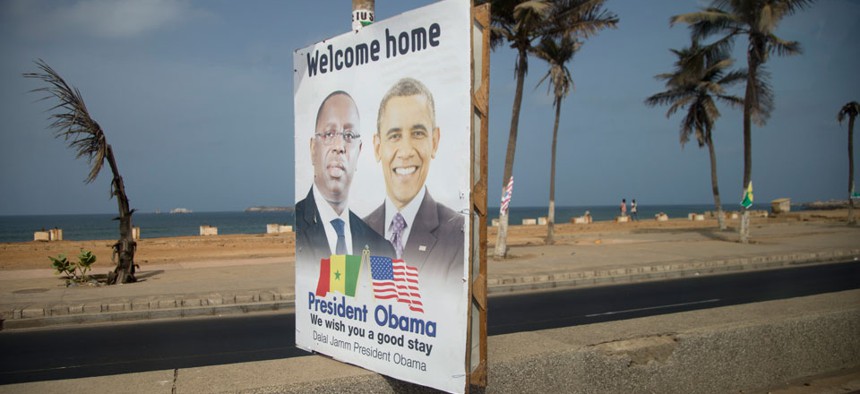
Carolyn Kaster/AP
African Terrorist Threat Not Far From Obama’s Mind
President's trip is focused on increased trade and development, but terrorist and extremist groups see growing opportunities in Africa too.
When President Obama lands in Dar es Salaam, Tanzania, next week, he will see a city that reflects the rapid changes that are reshaping Africa. The traffic-snarled streets are a riot of bright color, with buildings painted in splashes of pink and orange sherbet, and pedestrians dressed in blaring red dresses and screaming yellow soccer shirts. On the shoreline, large container ships will be stacked to the horizon of the Indian Ocean, bespeaking the economic miracle that has brought Africa’s average economic growth rate on par with Asia’s at nearly 6 percent.
But amid the chaotic traffic of Dar es Salaam--or “Haven of Peace”--Obama will see signs of a more fragile continent, threatened by terrorist groups drawn to its persistent poverty and ungoverned spaces. And he will be reminded of those dangerous forces on Tuesday, when he lays a wreath at the memorial for the victims of al-Qaida’s 1998 bombings of the U.S. embassies in Tanzania and Kenya that killed 224 people.
Because of African sensitivities about the presence of foreign military forces on the continent, the White House has gone to great lengths to stress that the president’s trip will focus on trade and investment, democratic institution-building, and reaching out to young Africans. But in many private discussions, counterterrorism partnership will also feature prominently.
“The growing threat that al-Qaida affiliates are posing to nations in north, east, and southwest Africa has really changed the dynamic by making counterterrorism a growth business on the continent, and there are some great capabilities we can offer those nations who want to partner with us,” Maj. Gen. Carlton Everhart II, AFRICOM’s senior Air Force commander, said in a recent interview.
Indeed, even as the U.S. military winds down operations in Afghanistan, Pentagon leaders see the threat from terrorists and extremists groups growing in much of Africa. They include al-Qaida in the Islamic Maghreb, which emerged from Algeria’s civil war of the 1990s and has amassed an estimated $90 million over the past decade from drug smuggling and kidnapping for ransom. The group was linked to the Benghazi consulate attack in Libya that killed Ambassador Chris Stevens and three other Americans last September; the assault on a natural-gas complex in Algeria in January that killed dozens of foreign oil workers, including three Americans; and the seizure of Northern Mali earlier this year by a loose confederation of Islamic extremists, criminal groups, and Tuareg mercenaries.
U.S. forces stationed in Djibouti, Africa, have used drones to target al-Qaida in the Arabian Peninsula in Yemen, and they are supporting African Union forces fighting the Qaida-affiliated terrorist group Al Shabaab in Somalia. According to U.S. military sources, Tanzania has also requested that the Pentagon help train Tanzanian forces for deployment in the nearby Democratic Republic of Congo as part of an African Union force.
In response to those growing threats and demands, the U.S. military’s Africa Command (AFRICOM) has increased its presence, weapons systems, and operations in Africa. It’s no accident that the new commander of AFRICOM is Gen. David Rodriguez, an experienced operational commander who helped manage the surge of U.S. forces in Afghanistan. Rodriguez recently told a Senate panel that the U.S. military needs to increase intelligence gathering in Africa by a factor of 15 to better track terrorist groups.
Because of African sensitivities and colonial past, AFRICOM maintains its headquarters in Germany and has only a light footprint on the continent that is centered in the tiny East African country of Djibouti, home to what’s known as the Combined Joint Task Force – Horn of Africa. Observant air travelers visiting Djibouti sometimes catch sight of U.S. Predator drones sitting on the taxiway on the military side of the airbase. Periodically, French Mirage and U.S. F-16 fighter jets, Japanese P-3 Patrol aircraft, and French Puma and U.S. HH-60 helicopters can also be seen launching from an airport where military aircraft and civilian airliners share a single runway.
But since Benghazi, AFRICOM has established a new rapid-reaction Embassy Response Force in Djibouti to conduct potential embassy evacuation missions in East Africa. The Marine Corps has deployed a counterpart located at the Naval Air Station in Sigonella, Spain, to cover North Africa.
Meanwhile, AFRICOM has built a new base for unmanned aerial drones in Niger to support operations in Mali, adding to a constellation that includes U.S. drone bases in Djibouti, Arba Minch in Ethiopia, and the Seychelles in the Indian Ocean.
“Rising threats combined with the drawdown in Afghanistan and elsewhere has led to speculation that Africa is becoming a theater of expansion for the U.S. military, and certainly in recent months we’ve seen some evidence of increased activity,” said Richard Downie, deputy director of the Africa Program at the Center for Strategic and International Studies.
Still, quiet U.S. military support for French troops in Mali and African Union troops in Somalia fit into an AFRICOM pattern of adopting a supporting role when possible.
“It’s true that [the Pentagon’s U.S. Africa Command] has been a key partner to a number of African nations,” said Deputy National Security Adviser Ben Rhodes just before the trip, citing U.S. military support to African troops fighting Qaida-affiliated terrorist groups in Mali and Somalia, and hunting for the messianic warlord Joseph Kony in the Central African Republic. “But all of those are U.S. operations in support of African partners who are really in the lead.”







